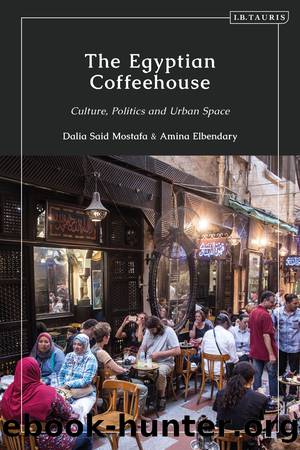The Egyptian Coffeehouse by Dalia Said Mostafa and Amina Elbendary

Author:Dalia Said Mostafa and Amina Elbendary
Language: eng
Format: epub
Publisher: Bloomsbury Publishing Plc
The café as a witness to the deterioration of urban living
Throughout the 1980s and 1990s, we observe how the motif of the fragmentation of the traditional alley was depicted in several popular films where this urban space came to bear witness to the remarkable changes that had constituted a âmalaiseâ in Egyptian cities: the sharp rise in unemployment, the unprecedented levels of urban poverty, the widespread use of drugs among youths, the inability to find decent housing in the big cities, the deterioration in the standard of public schools and universities, domestic violence against women and children, and much more. Such social ills led to the depiction in cinema of alienated, lonely, stoned or violent characters who had lost their bearing, or even their identity, in huge crowded cities that seemed to lose touch with humanity. These films were pointing to the social manifestations of the neoliberal era and how individuals from the low-income strata were struggling to make a living. The alley with its transformed identity was reflected visually in detail to mirror the breakdown in physical infrastructure caused by dysfunctional state institutions: lack of clean water; constant power cuts; crowded roads filled with garbage; air, food and land pollution; poor housing conditions and narrow dilapidated rooms where people are crammed because they have nowhere else to go.
The new-realist films of this era by directors such as Mohammad Khan, Atef al-Tayyeb, Khayri Bishara, Ossama Fawzi, Magdi Ahmed Ali, Radwan al-Kashif and Daoud Abdel Sayyed focused on how the protagonists had to cling to one another in their small communities to be able to survive, and one place where men were still able to meet and socialize was the ahwa baladi. Famous films such as Youm Morr, Youm Helw (Sour Day, Good Day, 1988) which starred the legendary actress Faten Hamama;36 al-Kitkat (Kitkat, 1991),37 a cinematic adaptation of Ibrahim Aslanâs novel The Heron (discussed in
Chapter 3); and Leih ya Banafseg (Violet Flowers, Why?, 1993),38 show the urban alley in this new light, through an illustration of the bottom layer of society to convey to the viewers the forceful changes which big cities, especially Cairo, were experiencing.
In this context, such representations encapsulate once again what scholar Asef Bayat has termed âthe city-inside-outâ, which we have highlighted in earlier chapters, where the urban poor are constantly present on the streets while taking their activities outdoors. But what cinema has done here is to show in meticulous detail the physical decay and mental deterioration of the characters within neoliberal economies. It is indeed the ânecessity to survive and live a dignified lifeâ, as Bayat argues,39 which drives these impoverished characters in the films to carry out their activities into the public space. In fact, we repeatedly see in some of the new-realist films of the 1980s and 1990s how the café is represented as the place where the âsubalternâ characters âexpress their grievances and resolve their problemsâ.40 It is true that the characters here attain some autonomy in the public space outside the
Download
This site does not store any files on its server. We only index and link to content provided by other sites. Please contact the content providers to delete copyright contents if any and email us, we'll remove relevant links or contents immediately.
What's Done in Darkness by Kayla Perrin(25499)
Shot Through the Heart: DI Grace Fisher 2 by Isabelle Grey(18219)
Shot Through the Heart by Mercy Celeste(18160)
The Fifty Shades Trilogy & Grey by E L James(17774)
The 3rd Cycle of the Betrayed Series Collection: Extremely Controversial Historical Thrillers (Betrayed Series Boxed set) by McCray Carolyn(13189)
The Subtle Art of Not Giving a F*ck by Mark Manson(12910)
Scorched Earth by Nick Kyme(11831)
Stepbrother Stories 2 - 21 Taboo Story Collection (Brother Sister Stepbrother Stepsister Taboo Pseudo Incest Family Virgin Creampie Pregnant Forced Pregnancy Breeding) by Roxi Harding(11040)
Drei Generationen auf dem Jakobsweg by Stein Pia(10216)
Suna by Ziefle Pia(10185)
Scythe by Neal Shusterman(9259)
International Relations from the Global South; Worlds of Difference; First Edition by Arlene B. Tickner & Karen Smith(8608)
Successful Proposal Strategies for Small Businesses: Using Knowledge Management ot Win Govenment, Private Sector, and International Contracts 3rd Edition by Robert Frey(8419)
This is Going to Hurt by Adam Kay(7693)
Dirty Filthy Fix: A Fixed Trilogy Novella by Laurelin Paige(6453)
He Loves Me...KNOT by RC Boldt(5804)
How to Make Love to a Negro Without Getting Tired by Dany LaFerrière(5378)
Interdimensional Brothel by F4U(5304)
Thankful For Her by Alexa Riley(5161)
